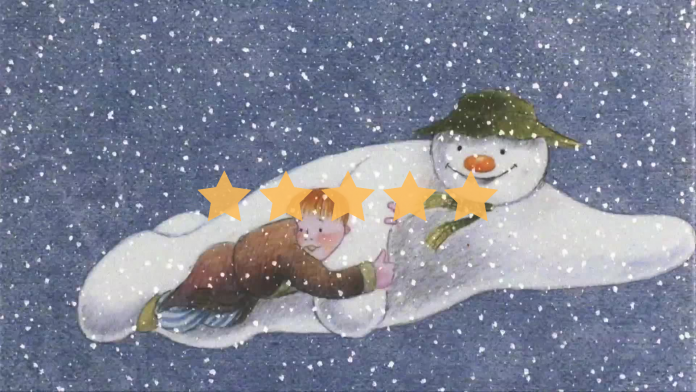There is one Christmas film that transcends farther than any tale on screen. The story of a young boy and his snowy companion.
★★★★★
The Christmas season is amongst us once again and various annual celebrations have commenced marking this special occasion. Through decades of cinematic history, countless festive films have captivated numerous audiences with their particular charms. Whether it’s It’s a Wonderful Life with James Stewart, or Will Ferrell as a certain elf, there are always neatly wrapped gifts to watch. However, The Snowman released back in 1982 is the one short that captures the pure essence of the holiday tremendously and, most remarkably, without dialogue of any kind.
Based on the 1978 picture book by Raymond Briggs, the story follows a young boy and his extraordinary adventure with a snowman on Christmas Eve night. Recently, orchestra company Carrot Productions conducted ‘The Snowman Tour’, which consisted of events presenting The Snowman with an exclusive twist: the accompaniment of a live orchestra.
The tour has played several venues including Salisbury Cathedral, home to the tallest church spire in the UK. With the presence of an astonishing repertoire of live performers, this tour highlighted why this short has touched the hearts of many and vitally, why musical scores are so invaluable for cinematic storytelling.
During the initial realisation of any production, filmmakers have a major responsibility to unite a diverse range of narrative tools, in order to communicate an emotion or sufficiently tell a story. Typically, your main recipe for an average film would comprise of a script, a cast of talented actors and the accompanying musical score. Ultimately, a film is aiming for both an auditory and visual representation that produces the highest effect. However, what if most of these core elements were stripped away to concentrate on one: the musical score. Before the introduction of sound in cinema throughout the 1920s, almost every film relied on an orchestral score to convey the story. Each musical performer serves to function simultaneously to transform two-dimensional images into the third dimension. The Snowman is a prime example of the exceptional collaboration between multiple elements emphasising the narrative.
At the heart of this story is essentially a normal boy and his best friend who just so happens to be a snowman. They share laughs and encounter various wintery wonders over the course of one night. The film translates its wordless source material gorgeously with beautiful hand-drawn animation and remarkable visuals. A short with effectively no three-act structure like you would experience with average cinematic affairs can basically stand out on its own without reliance on dialogue. Yet significantly, the musical score acts as the main catalyst of the boy and the snowman’s lively adventure.
Howard Blake’s orchestral soundtrack cements the underlying layers of The Snowman that brings together the film’s qualities. Since the score is through-composed meaning that it is continuous with no breaks, the orchestra effectively becomes the narrators. The absence of dialogue fundamentally means that this soundtrack takes on greater responsibility for generating the words, sounds and emotions of the narrative— and The Snowman accomplishes this so marvellously. When the applicable emotion is required in a sequence, multiple performers cooperate in controlling the tempo and accentuating the right melody. This harmonisation of each performer acing their part, effectively underscores every sequence beyond the animated pictures.
Perhaps the most iconic aspect that audiences remember almost 40 years after The Snowman’s release, is undoubtedly the main theme: “Walking in the Air” sung by Peter Auty. We hear this iconic piece during quite possibly the most famous segment in the film, where we experience the flight of the young boy and the snowman across Southern England. Preceding this moment, the score has been entirely instrumental so when Auty’s vocals dominate, it converts the pictures into something completely magical. Soaring across the Brighton Pier and Royal Pavilion feels transcendent and exceptional as a result of the lack of lyrics prior to this scene.
Profoundly, The Snowman is one of the greatest examples of music and film evidently coordinating in a magnificent way. It represents an intimate relationship that no other art form can achieve when designing a story. What crucially works is the simplicity of the plot, which allows for any musical interpretations no matter the genre. Nevertheless, what this animated short presents is a substantial synchronisation that could never become replicated so effortlessly again.
The Verdict
The Snowman, whilst simple in story and wordless, embodies a distinctive voice through its charm and elegance in its craft. For those who have yet to experience this animated classic, it deserves the highest praise it can receive and will endure as a golden standard for Christmas traditions for years to come.
Words by Ethan Soffe
Support The Indiependent
We’re trying to raise £200 a month to help cover our operational costs. This includes our ‘Writer of the Month’ awards, where we recognise the amazing work produced by our contributor team. If you’ve enjoyed reading our site, we’d really appreciate it if you could donate to The Indiependent. Whether you can give £1 or £10, you’d be making a huge difference to our small team.
